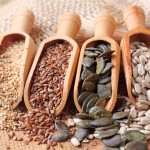Eating Healthy in the Fall Part 2
Continuing from part 1, here are more healthy foods that are best eaten in the Fall to keep away the flu and cold.
Squash
Unlike summer squash, winter squash has a fine texture and a slightly sweet flavour. Because of its thick skin, it can be stored for months. It tastes best with other fall flavourings, like cinnamon and ginger. Health benefits include:
• Contains omega-3 fatty acids
• Excellent source of vitamin A
Pumpkin
A type of winter squash, pumpkin can be used for much more than jack-o’-lanterns. Its sweet taste and moist texture make it ideal for pies, cakes, and even pudding! Health benefits include:
• Rich in potassium
• More than 20% of your daily required intake of fiber
• Good source of B vitamins
Sweet Potatoes
These veggies are for much more than Thanksgiving casseroles. More nutritionally dense than their white-potato counterparts, try roasting them—they’ll taste delicious, and you may maintain more vitamins than boiling. Health benefits include:
• Excellent source of vitamin A
• Good source of iron
• Anti-inflammatory benefits
Turnips
Tender and mild, these root vegetables are a great alternative to radishes and cabbage. To flavour these veggies, use fennel, bread crumbs, or even brown sugar. Turnip leaves, which taste like mustard leaves, are easy to cook and dense in nutrients. Health benefits include:
• The roots are a good source of vitamin C
• Turnip leaves are an excellent source of vitamins A, K, and folate
Pomegranates
This slightly sour fruit has gotten a lot of press as an antioxidant powerhouse. The juice provides a tangy base for marinades, and the seeds can be tossed into salads to amp up the flavour. Health benefits include:
• Pomegranate juice has higher antioxidant levels than red wine
• Good source of vitamin C and folate
Dates
This Middle Eastern favourite is a sweet fruit that is perfect braised in stews, chopped up in desserts, or stuffed with cream cheese or almonds. Health benefits include:
• Low in fat
• Good source of fiber
• Good source of potassium
Kiwi
Use this sweet fruit to add a tropical flavour to your recipes. It’s great mixed with strawberries, cantaloupe, or oranges and can be combined with pineapple to make a tangy chutney. Health benefits include:
• More vitamin C than an orange
• Good source of potassium and copper
• Skin has fiber & vitamin c
Grapefruit
The signature tartness of grapefruit provides a contrast to other citrus fruit. Add it to mixed greens, combine it with avocado and shrimp, or enjoy a fresh glass of its antioxidant-rich juice. Health benefits include:
• More than 75% of your daily recommended intake (DRI) of vitamin C
• Good source of lycopene
• Contains pectin, which has been shown to lower cholesterol
Tangerines
The small and sweet citrus fruits are positively refreshing for fall recipes. Our favourite flavour combos include almonds, dates, and honey. Juice them with oil, vinegar, and ginger for a to-die-for dressing. Health benefits include:
• Good source of vitamin C
• Good source of beta-carotene
Which are your favourite? Which have you tried? Have a recipe to share? Comment below and share your thoughts about Fall foods!
Follow and like Dr. Sunny Tatra on Twitter, Facebook, Instagram and Google+ to stay up to date with the latest news and tips. To read client reviews or to share your own experience, visit our RateMDs and Yelp pages. To book an appointment with Dr. Sunny Tatra and his team, phone +1 250 590 0166, email, or fill out the online appointment form!



